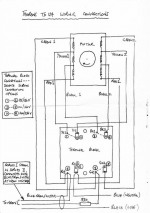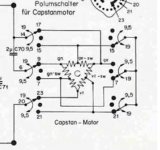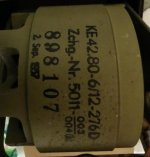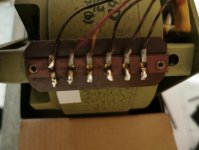Hello all !
I have found this PAPST motor in an amazing turntable, I can't find a datasheet about it.
Here are some photos of the device :


It seems to be a three phase induction motor coupled in star :

The black cable with three wires comes from the supply, the six other wires on the top of the photo go to the coils.
Do you know that motor ?
I have found this PAPST motor in an amazing turntable, I can't find a datasheet about it.
Here are some photos of the device :


It seems to be a three phase induction motor coupled in star :

The black cable with three wires comes from the supply, the six other wires on the top of the photo go to the coils.
Do you know that motor ?
Last edited:
Hi Arch Stanton, which turntable is this? This motor has been used on quite a few decks previously.
Kevin
Kevin
Last edited:
You are right I must measure between the wires to see how they are wired.
The turntable is fifty years old, the motor too.
It is a unique piece made by a French creator and designer Ernest Spiteri.


The turntable is fifty years old, the motor too.
It is a unique piece made by a French creator and designer Ernest Spiteri.


Last edited:
Hopefully this can help you.
No, that's the wiring diagram for the standard E50 induction motor - I have two TD-124, one of these has the original E50, and the other I upgraded to a.... 3 phase Papst Aussenlaufer.
Best bet would be to contact Papst to see if they can provide documentation for this motor - if it is an Aussenlaufer motor as I suspect it would benefit from running on 3 phase power. (In my very limited experience these are usually delta connected, but yours looks very different from the standard 3 wire configuration I am familiar with, maybe it is a Wye or has all independent windings.)
You might want to contact Jaap Pees at Hanze HiFi about motor drives they custom make for 3 phase papst motors. He may even be familiar with this motor. You can mention I suggested you reach out to him for advice.
That is a very cool TT by the way, love the look and the thoughtful, original design.
Many thanks for your answers.
Since the rotor turns ouside the stator it is an Aussenlaufer (that is what it means in German language I think).
I will desolder the star link (for now the power supply cable is fully disconnected) and do some measures on the wires, it will not be difficult to see if it is a three phase motor and if the coils are isolated.
It is an idler drive platter.
Since the rotor turns ouside the stator it is an Aussenlaufer (that is what it means in German language I think).
I will desolder the star link (for now the power supply cable is fully disconnected) and do some measures on the wires, it will not be difficult to see if it is a three phase motor and if the coils are isolated.
It is an idler drive platter.
I have a similar motor, which originally came, I believe from an old Studer tape deck. It is wired in a similar way, as you can see from the diagram below. From the info on the rotor it is a 6/12 pole motor, and will therefore run at 1000/500 rpm when connected to a 50Hz supply.
When running at the higher speed it is wired in star formation, for the lower speed it's delta.
When running at the higher speed it is wired in star formation, for the lower speed it's delta.
Attachments
Ralph, you are right, the wiring is exactly like yours.
The measure I have made give three values of resistors : 300/480/544 Ohms.
That is to say each coil is roughly 360 Ohms.
Now I must find what is the good power supply.
Many thanks to you.
The measure I have made give three values of resistors : 300/480/544 Ohms.
That is to say each coil is roughly 360 Ohms.
Now I must find what is the good power supply.
Many thanks to you.
linear servo tonearms
It appears Mr. Ernest Spiteri is a proponent of servo tangential tonearms. Very interesting designs!

It appears Mr. Ernest Spiteri is a proponent of servo tangential tonearms. Very interesting designs!

Last edited:
@kevinkr, my apologies I did in fact post the incorrect information. My head is not currently fully in the game.
@arch, here is a link to a page that may help https://theanalogdept.com/papst_aussenlaufer.htm
Regards, Kevin
@arch, here is a link to a page that may help https://theanalogdept.com/papst_aussenlaufer.htm
Regards, Kevin
The Papst motor specified for the TD124 has a model number beginning with 902,
I believe this indicates that the motor is not 'fully' synchronous, those start with 901.
The difference is caused by the type of steel used in the rotor; synchronous versions use a
steel with a higher retentivity, turning it into a sort of permanent magnet motor; the steel
used in the 902 version allows for some speed variation with load, more like an induction motor.
I believe this indicates that the motor is not 'fully' synchronous, those start with 901.
The difference is caused by the type of steel used in the rotor; synchronous versions use a
steel with a higher retentivity, turning it into a sort of permanent magnet motor; the steel
used in the 902 version allows for some speed variation with load, more like an induction motor.
Ralph, you are correct, it is an induction motor like the E50, since the eddy current brake is still used for speed control (unless you use an external VFD) the motor needs to be able to slip a little.
- Home
- Source & Line
- Analogue Source
- Do you have the specs of this motor ?





